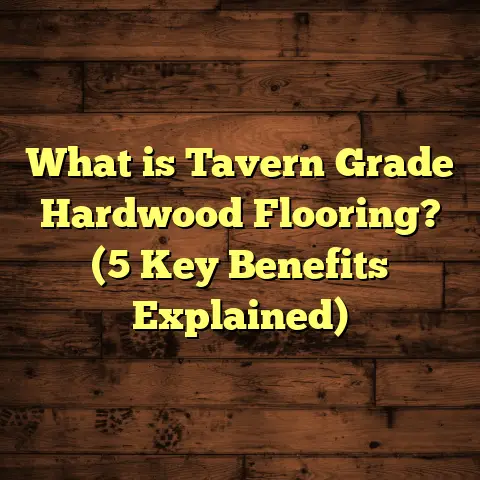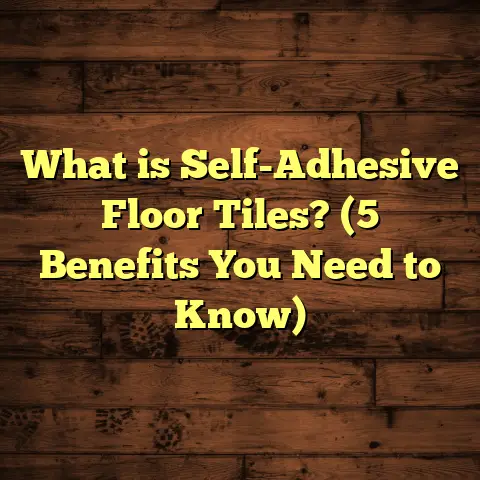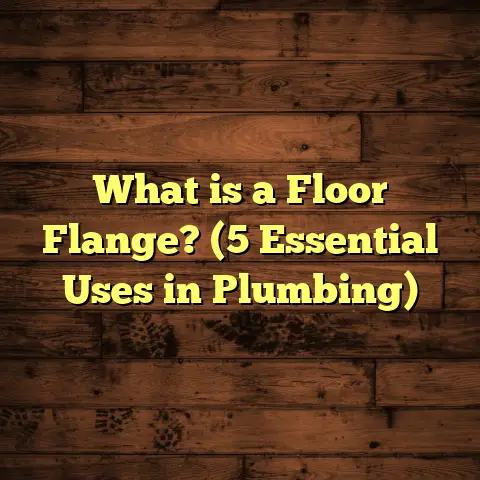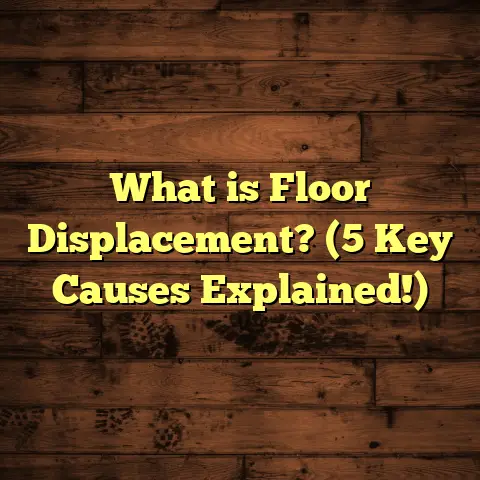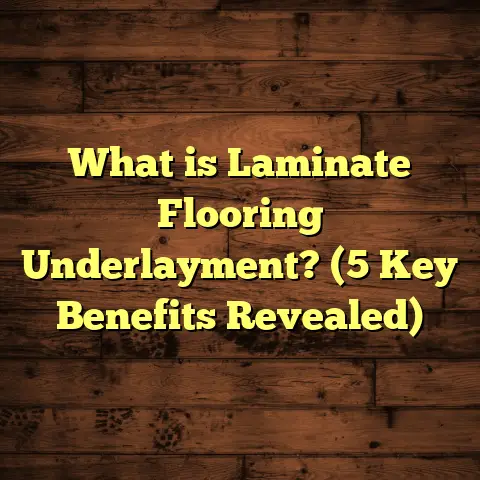What is No Wax Vinyl Flooring? (5 Key Benefits Explained)
Have you ever thought about how much time and effort goes into keeping your floors looking nice? What if I told you there’s a type of flooring that can save you hours of work every month, while still looking great and holding up well to daily wear? That’s exactly why I want to talk about no wax vinyl flooring, a product I’ve installed and lived with that totally changed my view on floor maintenance.
What is No Wax Vinyl Flooring?
No wax vinyl flooring is a kind of resilient flooring made from synthetic materials—primarily PVC—that has a factory-applied protective finish. Unlike traditional vinyl that requires periodic waxing to maintain its shine and durability, no wax vinyl comes ready to use straight out of the box. This means you don’t have to apply or strip wax layers regularly to protect it.
The surface layer includes a clear, durable coating that resists scratches, scuffs, stains, and dirt. This finish replaces the need for waxing and buffing, which were once necessary to keep vinyl floors looking fresh. It’s sometimes called “no-polish” or “maintenance-free” vinyl because of this feature.
The wear layer on no wax vinyl floors typically ranges from 12 mils (0.3 mm) to 20 mils (0.5 mm), which provides enough thickness to protect the floor under regular foot traffic. The thicker the wear layer, the more durable and long-lasting the floor is.
This type of flooring comes in many forms: sheets, planks, and tiles. Each form has installation methods suited for different spaces and needs.
How Does No Wax Vinyl Differ from Traditional Vinyl?
Traditional vinyl floors are made from similar materials but lack the factory finish that protects them without waxing. Over time, the surface can dull or get scratched easily if not regularly waxed and buffed. The waxing process adds a protective layer but needs attention every few months or so.
No wax vinyl eliminates this hassle by having a built-in protective layer applied during manufacturing. This finish is tough enough to resist damage and maintain shine without extra treatment.
Why I Recommend No Wax Vinyl Flooring
From my experience installing various types of flooring, I can say no wax vinyl is one of those rare products that genuinely delivers on convenience without sacrificing quality.
When I first started using no wax vinyl in commercial projects about five years ago, I noticed how much easier it was for cleaning staff to maintain a pristine look compared to older waxed floors. The maintenance savings alone were impressive.
For homeowners, this means less time spent on floor care and more time enjoying your space.
Installation Insights: What You Need to Know
Installing no wax vinyl flooring is fairly straightforward but does require attention to detail for best results.
Preparing the Subfloor
One of the most important steps is preparing the subfloor. Whether you’re installing sheet vinyl or vinyl planks, the subfloor must be:
- Clean: No dust, dirt, or debris.
- Dry: Moisture can cause issues like mold or adhesive failure.
- Level: Uneven spots can cause the vinyl to crack or bubble.
For concrete subfloors, I always recommend using a moisture barrier or vapor retarder underlayment because moisture can seep through concrete and damage vinyl over time.
Installation Methods
- Sheets: Usually glued down with adhesive. Seams need to be sealed carefully using seam tape or welding to prevent water ingress.
- Tiles: Can be glued down or be loose-lay depending on product type.
- Planks: Often come with click-lock systems or glue-down options.
I recently installed a no wax vinyl click-lock plank floor in a small office. The process was quick since there was no need for messy glue drying times, and the planks locked tightly together with minimal gaps.
Common Installation Mistakes
- Skipping subfloor prep: This leads to uneven surfaces and premature wear.
- Using improper adhesives or skipping moisture barriers: Can cause bubbling or peeling.
- Poor seam sealing in sheet vinyl: Water damage risk increases drastically.
Maintenance: Keeping Your Floor Looking New
No wax vinyl flooring is famous for being low maintenance, but it’s not completely “set it and forget it.” Regular care ensures your floor looks great for years.
Daily Cleaning
Sweeping or vacuuming regularly removes dirt and grit that can scratch the surface. I recommend using a soft broom or vacuum designed for hard floors.
Weekly or Monthly Cleaning
Use a damp mop with a neutral cleaner specifically made for vinyl floors. Avoid harsh detergents, bleach, ammonia-based cleaners, or abrasive tools as these can degrade the protective finish.
One of my clients used an all-purpose cleaner that wasn’t safe for vinyl and noticed dulling after several months—switched to a pH-neutral cleaner, and the shine returned within weeks.
Handling Spills and Stains
Wipe spills immediately. Most stains come from food, drinks, or oils that can penetrate if left too long. For tough stains like ink or paint, use vinyl-safe stain removers or rubbing alcohol sparingly.
Avoiding Damage
While no wax vinyl is durable, sharp objects can still cause cuts or gouges. Use furniture pads under heavy items and avoid dragging furniture across the floor.
When Things Go Wrong
If you notice scratches or dull spots after years of use, some manufacturers offer repair kits. These often include fillers or special polishes that restore appearance without needing full replacement.
What Makes No Wax Vinyl Flooring Popular? Five Key Benefits Explained
I’ve already mentioned some advantages casually, but let’s break down why this flooring type has gained so much traction among homeowners and businesses alike.
1. Time-Saving Maintenance
Waxing traditional vinyl floors can take several hours and involves multiple steps: stripping old wax, applying new coats, drying times, buffing. No wax vinyl skips all that. You just clean it up regularly — that’s it!
In one project at a daycare center I did recently, staff shared they saved about 12 hours per month previously spent on waxing floors.
2. Cost Savings Over Time
Though initial installation cost may be slightly higher than basic vinyl (typically $2-$5 per square foot versus $1-$3), you save money on supplies like wax, strippers, polishers as well as labor costs if you hire cleaning staff.
A study by the Resilient Floor Covering Institute (RFCI) found that maintenance expenses dropped by up to 50% over 10 years when switching from waxed to no wax vinyl floors.
3. Durability Against Wear and Tear
No wax vinyl’s thick wear layer protects against scratches from shoes, pet claws, furniture movement, and heavy foot traffic. In commercial spaces like retail stores or offices, these floors maintain their look much longer than older types of vinyl or laminate floors.
For instance, a retail client reported less than 10% visible wear after two years despite daily shoppers.
4. Better Indoor Air Quality
Wax products often contain volatile organic compounds (VOCs) that contribute to indoor air pollution. Since no wax vinyl eliminates the need for waxing chemicals altogether, indoor air quality improves significantly.
This was especially important for one client with asthma who noticed fewer flare-ups after installing no wax vinyl throughout their home.
5. Style Variety That Fits Your Taste
No wax vinyl comes in a huge range of styles—from realistic wood grain textures to stone-look tiles and abstract patterns. You can find options that mimic hardwood or ceramic tile without the cost or maintenance headaches.
I helped a couple choose wood-look vinyl planks that matched their rustic farmhouse decor perfectly—no one could tell it wasn’t real wood!
More Than Floors: Environmental Considerations
You might wonder about how eco-friendly no wax vinyl floors are compared to other options like hardwood or carpet.
Vinyl is a synthetic material made from polyvinyl chloride (PVC), which has environmental concerns related to production and disposal. However:
- Many manufacturers now produce low-VOC products certified by organizations such as FloorScore.
- Some brands offer recyclable vinyl products.
- The longer lifespan and lower maintenance reduce waste from replacement floors and chemical use.
I always advise clients wanting greener options to research brands carefully and consider lifecycle impact before deciding.
Comparing No Wax Vinyl with Other Flooring Types
If you’re still weighing options, here’s how no wax vinyl stacks up against some popular alternatives:
| Flooring Type | Maintenance | Durability | Cost per sq ft | Installation Difficulty | Style Options |
|---|---|---|---|---|---|
| No Wax Vinyl | Low (no waxing needed) | High (wear resistant) | $2-$5 | Moderate | Very wide |
| Hardwood | Medium (polishing required) | Medium-High | $5-$10 | Hard | Classic natural look |
| Laminate | Medium (cleaning only) | Medium | $1-$4 | Easy | Good variety |
| Carpet | High (vacuum + deep clean) | Low | $1-$5 | Easy | Limited |
| Traditional Vinyl | High (waxing needed) | Medium | $1-$3 | Moderate | Good |
In my experience working with clients who want both durability and ease of care, no wax vinyl often hits the sweet spot.
Personal Anecdotes From My Projects
Let me share some stories from my work installing no wax vinyl flooring:
- Small Office Space: The owner wanted something professional looking but easy for janitors to clean daily. No wax vinyl plank flooring installed with click-lock system was perfect—quick install plus minimal upkeep.
- Family Kitchen Remodel: I recommended no wax sheet vinyl for its water resistance and softness underfoot compared to tile. The family loves how easy cleanup is after cooking messes.
- Retail Store Upgrade: After switching from traditional waxed floors to no wax tiles, employees reported safer footing (no slippery wax buildup) and management noticed less downtime spent on floor care.
Can You Install No Wax Vinyl Flooring Yourself?
Definitely! If you have basic DIY skills, installing no wax vinyl plank flooring with click-lock edges is quite manageable. Just ensure your subfloor is ready and follow manufacturer instructions carefully.
For sheet goods or glue-down tiles, it’s usually better to hire a pro unless you have experience because mistakes on seams or adhesive application can cause issues later.
If you want an estimate of costs based on your area or project size, tools like FloorTally can help by factoring in local labor rates and material prices.
How Long Does No Wax Vinyl Flooring Last?
With proper installation and care, no wax vinyl floors can last anywhere from 10 to 20 years. That’s comparable or better than many laminate or traditional vinyl floors.
In commercial settings with high foot traffic, expect closer to 10-15 years before replacement might be needed; residential floors often last longer as usage is lighter.
Addressing Common Concerns About No Wax Vinyl Flooring
Will It Look Dull Over Time?
Because of its factory-applied finish, no wax vinyl maintains shine much better than traditional types. However, extreme wear or improper cleaning products can dull it over time. Using recommended cleaners helps preserve appearance.
Is No Wax Vinyl Slippery?
No wax floors are generally designed with some texture for grip. Some products have enhanced slip resistance ratings suitable for wet areas like kitchens or healthcare facilities.
Can It Be Used in Bathrooms?
Yes! No wax vinyl’s moisture resistance makes it ideal for bathrooms and laundry rooms where water exposure happens regularly.
Tools and Products I Recommend for No Wax Vinyl Care
Based on my experience:
- Brooms with soft bristles
- Vacuums without beater bars (to avoid scratching)
- Microfiber mops with spray bottles
- pH-neutral cleaners like Bona Hard-Surface Cleaner or Armstrong S-485
- Vinyl-safe spot cleaners for tough stains
Avoid anything abrasive like steel wool or harsh chemical cleaners containing ammonia or bleach.
Summary of Key Takeaways
Here’s what stands out about no wax vinyl flooring from my perspective:
- Eliminates waxing hassle while keeping floors protected
- Durable enough for heavy traffic areas
- Saves money on maintenance supplies and labor
- Offers many styles that fit different decors
- Easy installation options including DIY-friendly click-lock planks
- Improves indoor air quality by avoiding waxing chemicals
- Suitable for kitchens, bathrooms, offices, retail shops, and homes
Final Reflection
I’ve been in the flooring business for years now, working with many materials from hardwoods to laminate to carpet. No wax vinyl flooring remains one of my favorite recommendations when people want something practical yet stylish—and above all, easy to maintain.
If you’re tired of spending weekends waxing your floors or worried about harsh chemicals in your home’s air, this might be exactly what you need. It’s worth checking out samples at your local flooring store or asking contractors about no wax options for your next remodel or build.
Have you ever tried no wax vinyl flooring? What was your experience? Feel free to ask me any questions—you might be surprised how much easier life gets without the waxing routine!
